Webinar Transcript
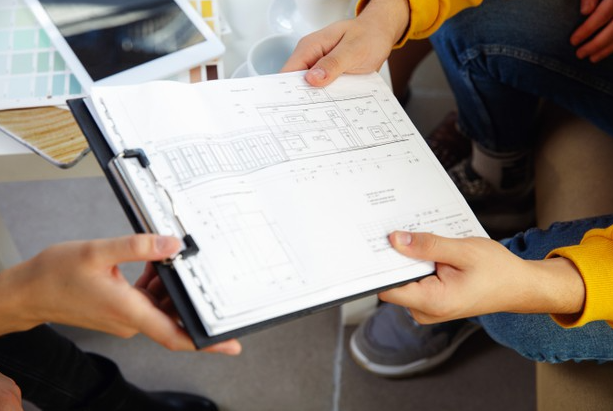
Gavin Roberts Speaking: Hi, everyone, welcome to this Webinar. This is Gavin Roberts, business account manager at PatSketch, signing in from India and welcoming you all for this webinar today. The topic for this webinar is “Customer Success Stories on Patent Drawings”.
I will go ahead to introduce our speaker and welcome all the participants from different countries. Your participation is a wonderful encouragement to the efforts and attempts that we are making. This will help us raise awareness and spread the knowledge owned by PatSketch. This has been possible by working for several years with the inventors, R&D organizations, IP departments, and IP law practices.
Our Speaker for the session is Hemant Kumar. He is a senior manager with our illustration team and holds an experience of more than 12 years in the patent industry with the IP expertise of patent illustration. He owns experience in utility drawings, design drawings, plant drawings, responding or reading to the office actions on drawings, preparing the replacement sheets, and so on. Welcome to the webinar, Hemant.
Hemant Kumar Speaking: Hey, thanks, Gavin, for having me on the Webinar. It’s a great pleasure to be here.
Gavin Roberts Speaking: Thank you, Hemant. It is my pleasure indeed to have you as our lead speaker for today’s program. Before we start the presentation today, let me ask Hemant for his initial remarks on today’s webinar topic “Customer Success Stories on Patent Drawings“. Over to you, Hemant.
Also Read: Role of Engineering Drawings in Patent Applications
Context of the Webinar
Hemant Kumar Speaking: This webinar covers some intriguing points that applicants can derive from by going through the customer success stories on patent drawings. This will include customer success stories on patent drawings – case studies, challenges, their solutions, and the final result achieved. The audience will be able to correlate with all these challenges and will get the insight to overcome these challenges without digging into their pockets. Further, they would be able to save a couple of dollars as well.
Gavin Roberts Speaking: Thank you, Hemant. Thank you for sharing the insight and your initial remarks and setting up the context for this webinar.
Note: The attendees for this webinar can avail to draw 4 drawings with PatSketch at no cost. This offer is valid for the attendees of this webinar. For placing the request, they can write an email at [email protected].
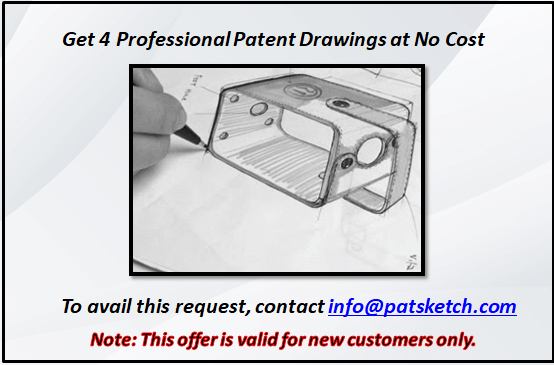
Also Read: Use of Patent Drawings in Artificial Intelligence
Agenda of the Webinar
Hemant Kumar Speaking: The key-points falling under this topic are
- Customer success stories on patent drawings based on the case studies;
- Challenges in the customer success stories on patent drawings;
- Solutions, and;
- PatSketch’s offerings and USPs.
Case Study–1
Let us start with the first customer success stories on patent drawings. The client is a manufacturer for adhesive and sealant. He is one of the leading manufacturers who work in chemicals, craftsmanship products, do it user products, automotive chemicals, art materials, stationaries, etc.
They had filed some provisional patent applications successfully and they decided to file the non-provisional patent application at USPTO. They’ve submitted 5 patent applications without knowing the consequences and the requirements for a non-provisional patent application. Further, they submitted the same photographs that they used for the provisional patent application.
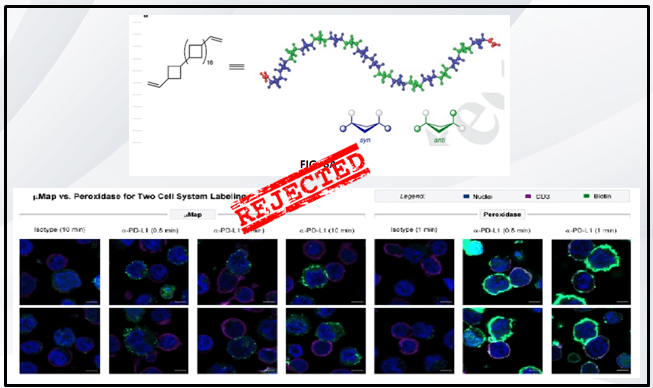
Thus, at the time of examination, they received rejection due to non-compliance with the drawing guidelines submitted with the patent application. They thought they can submit the drawings at USPTO under section 37 CFR 1.84. This states that the colored photographs are valid only for utility and design patent application.
Though it is true, However, it is equally important to know how to use them and when to use them. For example, these two photographs belong to the same patent application. At first, they look similar in terms of their nature. They both have complex textures and contain colors. Further, they both received objection to under Section 37 CFR 1.84 and both received corrections with different procedures.
Also Read: How Patent Illustrators Help You in Saving Time, Money, and Effort
First Image – Steps Taken by the PatSketch Experts
The first photograph of a polymer structure followed amendments as per section 37 CFR 1.84 section A. This clearly states the use of black ink only. You must draw black and white drawings normally with patent ink – Indian ink. Further, it is anything equivalent to this ink that secures solid black lines and offers usage in patent drawings.
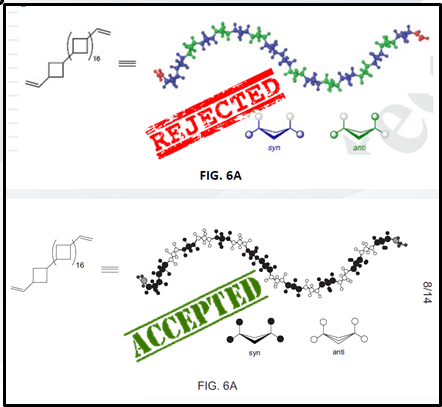
At first, we went with the formalization of the line drawings for this application. Considering the details and claimed part based on the picture and office action received, we prepared all the line drawings inch by inch for all the views. This is so that its details get a proper exposure and one can understand them clearly without introducing any new subject matter.
However, the task doesn’t end here with preparing the line drawings. For patent applications, all the parts and views must remain consistent. Now, the most challenging part was to differentiate the colors without using them in the line drawings. Thus, we used appropriate hatching patterns to show the characters of the colors (shown in the example). However, you must ensure not to use any hatch pattern just to differentiate colors. These are the specific guidelines that one must follow to avoid further office action.
Let us have a look at the hatching patterns that we can use. There are hatching patterns available for the materials like metal, concrete, wood. In case, you want to add any other color, there are other hatching patterns available. Thus, this is where receiving a professional approach is always a wise decision.
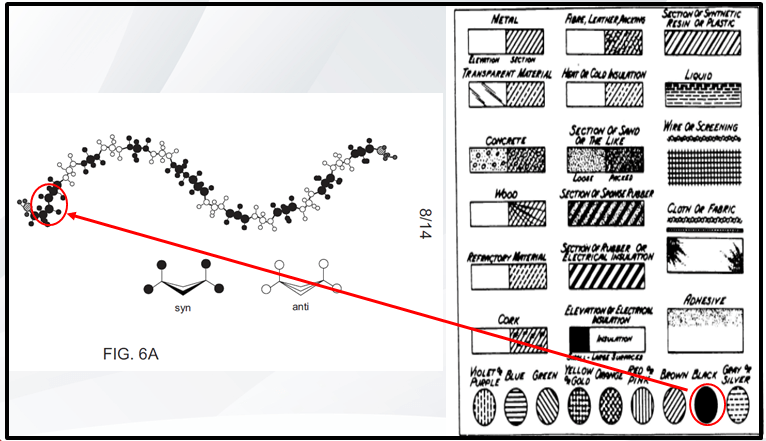
Also Read: Prepare Cost-effective Patent Drawings – Accepted Across Countries
Submit Your Drawings to Multiple Jurisdictions at Ease
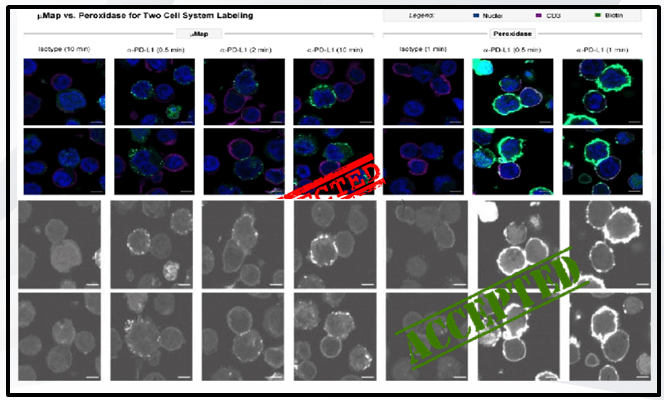
The second photograph of the same application includes colors and received rejection due to non-compliance. The USPTO, PCT WIPO have strict guidelines to convert the photographs into line drawings. However, you cannot convert every into line drawings. Since you can use photographs to some extent, for this, we used another process followed by 37 CFR 1.84 Section B. This Section allows the use of color drawings, unlike Section A.
Thus, just when we were about to formalize the color photographs as per the USPTO guidelines, the client changed his mind. He asked if he can file the same internationally for PCT WIPO.
Note: This way you can submit the same set of formal patent drawings to multiple jurisdictions without stretching your time and pocket. Further, this will help you save a couple of dollars, too.
We must understand that the USPTO and PCT WIPO, and almost every jurisdiction allow black line drawings on white paper. However, when it comes to color photographs, USPTO allows them, but WIPO doesn’t. Thus, whenever you plan to file internationally, please make sure to discuss this with your professional patent illustrator. If your patent illustrator very well knows about these guidelines, you can surely make international and USPTO-acceptable drawings.
Also Read: How to Avoid USPTO Rejections Over Patent Drawings
Second Image – Steps taken by PatSketch Experts
This section deals with how we managed to complete the second image for both USPTO and PCT WIPO at the same time. There are 2-3 processes in which the initial processes are the image requirement. Since the photographs become blurry and poorly visible while using them, they require a lot of focus to get the idea of the visuals. Therefore, we use multiple applications including Photoshop with other image processing applications. This helps to maintain the required DPI which is 300 DPI for photographs.
Note: This is one of the most important points of compliance and to meet that, we sharpen the quality and maximize the visibility. This is why we require an expert who knows what DPI is suitable for the printed images and how one can achieve it.
Next comes the preparation part. After refining and enhancing the resolution of the images, we inserted them into the CAD programs to proceed further. We added all the information as per the patent application requirements. These included the reference number, figure numbers, sheet numbers, and other informative text.
The third and the most important point here was to make sure that the drawings are complying with USPTO and PCT WIPO at the same time. Thus, after including all the required information, such as images, text, referral numbers, etc, it is important to ensure that these drawings are following the patent guidelines. Otherwise, the patent application may receive multiple rejections. Thus, all the checkpoints of deadlines such as margins, text size, image quality, image resolution, image DPI, line quality sheet size, number of required views, etc. were in place. Further, after having multiple quality checks, we shared the patent drawings with the client.
Related Article: Patent Diagrams – Requirement of Informal Reference for Better Drawings
What Did We Achieve?
- Timely Response: the client was able to respond with the revised patent drawings on time and successfully filed this application.
- Satisfaction: the outcome satisfied the client and he identified that the correct approach can save everyone’s time and cost.
- Saved and cost: the client is now more confident in filing under multiple jurisdictions without spending more on drawings.
Thus, this was one of the customer success stories on patent drawings which required professional help while filing or correcting the patent drawings.
Case Study–2
Let us see the other customer success stories on patent drawings. The client is one of the top motor cooperation multination automatic manufacturers, with headquarters in Germany, Japan, and the US. Their IP department filed a design patent application under USPTO as well as China with the same set of drawings.
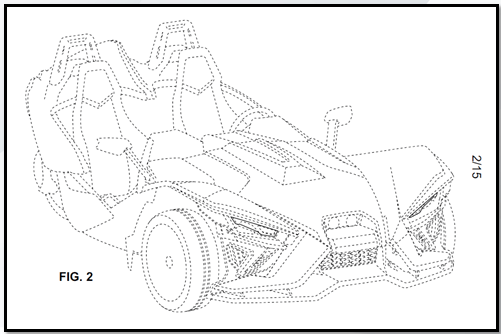
Again, they both faced rejection due to the same reason of non-compliance. Thus, we must understand that every jurisdiction has its guidelines where some of them are very common yet some are opposite. The following section shows how we corrected these drawings for USPTO based on the rejections they faced for unclear local line disclosures.
One can use broken line disclosures for illustrative purposes only, and do not consider them as a part of the claimed design. It is necessary to disclose the environment connected to the design claimed and to also show the boundary of the claimed part. The use of broken lines or dashed lines helps in representing the article in which the claim is embodied. Thus, one typically uses broken lines for the unclaimed portion of the design to show the environment in which the article is embodying the design.
The claimed subject matter should form no part of the claimed design or a specified embodiment. A person can also use broken lines to define the bonds of a claimed design when the boundary doesn’t exist within the article, embodying the claim. Thus, the claim designed goes to the boundary but does not include the boundary area.
Also Read: Secrets to Avoid EPO Rejections in Patent Drawings
Modifying Drawings Involving Broken Line Disclosures
However, it may be clear from this specification that the boundary of the claimed designs maybe a straight broken line. This connects the end of existing solid lines that define the claimed design. Any individual can then modify the drawing to feature a straight broken line connecting the ends of existing solid lines, defining the claimed portion. However, one must make sure not to include any broken line boundary other than a straight broken line. This can introduce a new subject matter and can invite further office actions.
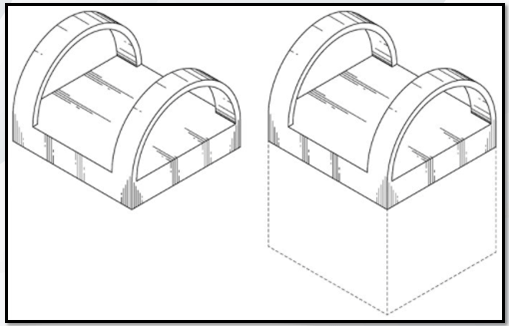
Let us understand the broken line usage to avoid these kinds of rejections. We know that broken lines do not show hidden planes, hidden surfaces, or interior things. It doesn’t show the relative parts of a design. Further, the broken line shouldn’t cross the claimed design. Also, you must not take its line weight or darkness, or thickness more than the lines used to show the claimed design. Thus, one must make sure to use broken lines with less thickness.
One must note here that broken lines cross over the solid line showing the claimed design and show them as an involvement. Thus, the surface which lines the broken line is a component of the claimed design. Thus, when broken lines cross over the design path, you can call them boundaries. Broken lines generally help in disclosing the environment related to the design. Further, they also show the boundary of the claimed design. Further, it can also show the portion of a design that forms no part of the claimed design.
Related Article: How to Correct Patent Drawings Rejected Due to Unclear Broken Line Disclosures
Objection on the Uses of Broken Lines
Dotted lines or broken lines show the environmental structure of the design and should not cross representation of the claimed design. Such types of dashed or broken lines may restrict the claimed design and disclose non-enabled and indefinite. This may also pose a common error. Thus, how can we properly disclose with the help of broken lines?
If broken lines are necessarily closing the solid line of the claimed design, then one must add a separate figure in addition to the figures showing only the claimed portion of the design. Such an illustration should fully disclose the subject matter of the design as shown here. For USPTO, the formal drawings were revised, based on the broken line placement and uses. This made them ready to face submission without an issue. Thus, the client can now file the same set of drawings for the PCT WIPO without any challenges or amendments.
However, another challenge here is to make the drawings competent for the China Patent Office. The client here had already paid for the USPTO drawings and was ready to pay even more to overcome the rejections received from the China Patent Office. Thus, it is extremely important to discuss with your patent illustrator. This will help you in receiving the drawings complying with USPTO and China with less effort and time. This will help in reducing the cost and time of the client. The next section discusses the reason why the revised drawings were appropriate for USPTO but not for China.
Also Read: Utility Patent Drawings – How to Avoid Office Actions
Differences between USPTO AND CPO Guidelines
Sheet size Requirements
You can file the USPTO formal drawings on A-4 sheet size and letter size paper. However, you can file China formal drawings on A-4 sheet size, only.
Shading Requirements
Those who are aware of the USPTO guidelines know that it is important to add shadings in patent drawings. This gives an edge to the drawings and makes them look more realistic and accurate. This requirement also makes USPTO design drawings appear more artistic than those of other countries. Design drawings with surface shading lines are acceptable under USPTO and PCT WIPO as well. However, the same type of shading is prohibited for China patent applications. Thus, whether it is utility or design, they have strict guidelines of not using any surface shading in any of the patent drawings.
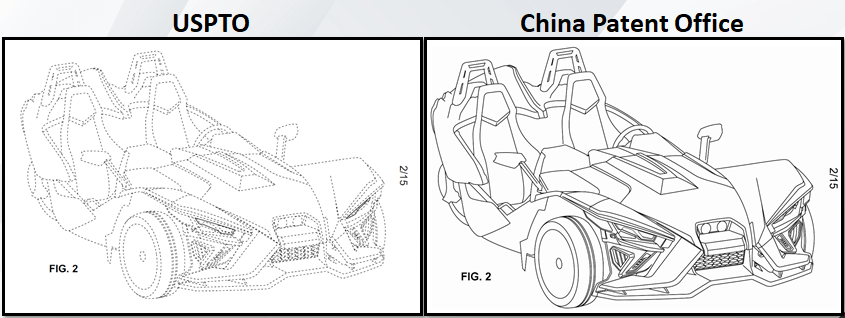
Broken Line Usage
We know the importance of the broken lines and their usage corresponding to the nature of the design drawings in USPTO. The same broken lines are restricted for use in China patent applications. Thus, the China application must include the design drawings with a brief explanation and indicate the essential portion of the design. Unlike, the USPTO and other countries in China, the drawings do not include shading or broken lines to indicate non-essential features. Thus, it is always a better practice to eliminate non-essential features from the drawings.
Hatching Patterns
While preparing any formal drawing for China, you must keep a thorough check on this point.
Further, there is one more big difference between design patents in USPTO and China. It is that the US design patent must pass a substantive examination, including a review of the obviousness and prior art. In China, you must undergo only one examination which checks whether the application is complete with drawings and the power of attorney. Thus, after taking care of these essential points and having multiple quality checks as per the associated guidelines, the experts submitted the correct formal drawings to the client for the China Patent Office.
Also Read: Preparing Patent Drawings: Key Points to Remember
The Result Achieved
- Cost Optimization: the client was able to optimize the overall operation cost.
- Secondly, the client saved cost on office action responses.
- The client avoided, saved from getting further office action.
- Lastly, the client was satisfied with the outcome and successfully filed the patent drawings to multiple jurisdictions without spending any extra cost.
Summary – Important Aspects and Guidelines
This was one of the customer success stories on patent drawings we encountered that required professional help while filing and correcting the patent drawings. In summary, the important aspects and guidelines we have covered so far include the following.
- Size of the sheet: patent office usually keeps specific guidelines in place with regards to the size of the sheets. When sheet size is not as per the guidelines, it may result in an office action. The most accepted sheet size is A-4 sheet size.
- Margin issues: the issue occurs when the margin is not correct and the drawings overlap with the boundaries. Make sure the same should be adjusted as per the selected sheet size.
- Hatching patterns: The USPTO has a specific universal requirement that can be used for PCT WIPO, but not for China.
- Shading: it is permitted to USPTO and PCT, but not in China. Thus, you must use it as per the associated guidelines or jurisdiction.
- Color Drawings: they are accepted to some extent only.
- Different types of lines: these include solid lines, shading lines, dashed lines, etc. that should be used properly to avoid rejections and confusion.
Thus, this way the case studies can help you to understand about filing patent applications to multiple jurisdictions while saving more on your pocket.
Also Read: The Importance of Patent Drawing Examples
PatSketch Offerings and USP’s
Gavin Roberts Speaking: This section talks about our offerings and our USPs for the drawings.
Flat Fee
We charge a flat fee for utility and design patent drawings. The fee goes per figure. However, there are no additional costs and no hidden charges. The quotation given before the approval relates to the final cost until there are any additions to the figure.
100% Compliance Offered
We provide 100% compliance to any of the Patent Office rules whether it comes under USPTO, WIPO, EPO, China, Japan, or any other patent office. The client only needs to mention the patent office they want to apply for. Our drafting team can prepare it as per the given guidelines.
Easy Delivery of Drawings
We make it easy for clients to order and get the delivery of the drawings. We have different panels. You can use the online panel and visit the website to order and select your delivery deadline as per your requirement. Further, you can also opt for the option of expediting the order. Finally, you will be updated with the delivery time then and there. Further, within that delivery time slot, you will receive your drawings as well. Also, if there would be any other option required, then you can also send an email to the info id.
Output and the Deliverable
We generally provide the same in PDF format. However, we can deliver the other formats like JPG, Visio, STL files, or any other 3-D format required by the client.
30+ Experienced Draftsmen
We are a team of 30+ experienced draft-persons who know the latest software and technologies. We particularly focus on the domains we are going to work on for the drawings. Further, we are very active in coordinating or discussing the matter if there is any confusion.
Modifications to Drawings at Ease
We provide the cost lists, iterations, and modifications to the drawings. It generally happens that there are certain changes that the client needs for their drawings. Further, when they get back to any vendor, then they charge it from the base. However, if we are preparing any drawings and our clients need any changes, we’ll do it at no cost. Thus, within 24 working hours, you’ll get your revised set.
Different Time Zones
Further, we are available as per the different time zones. Considering Europe or Japan or any other country, our service managers will be available for that time slot. Further, they will technically respond to that.
Dedicated Relationship Manager
The ones who are placing the order with us and are using our services, we provide them with a dedicated relationship manager. This person will answer any of the queries or can help clients to place the order if they don’t want to place it online. The clients will send the details and all the things will be handled by your relationship manager.
Thus, these are certain USPs that anyone can avail of by using PatSketch – SuperEasy Patent Drawings Ordering Platform. The clients will get their drawings done in a cost-effective and accurate format.
Also Read: WIPO Patent Drawing Rules for PCT Applications
Questions/Answer
Which one is better out of black and white Line, Colour, or Gray-scale images?
Hemant Kumar Speaking: The line drawings are indeed the best option for filing patent drawings. However, colored drawings and photographs are not ordinarily permitted for utility or design patent application. Thus, we can choose any of them based on the application and the jurisdictions, but still, line drawings are the best among these. Thank you.
Which font size should be used? Can I use the text size with more than the standard size?
Hemant Kumar Speaking: I want to specify that the guidelines for these characters are universal. The context should be uniform in style and size. Also, they should be oriented in the same direction as the view and should not cross or overlap or interact with any object to maintain the sanity of the drawings. However, the most important aspect with leads to an office section is the size or the height of the font. This must remain at least 0.32 cm. Any context less than 0.32 cm in size is not permitted. Thank you.
Should I be worried about the blurriness of the submitted picture? How can I enhance the quality of the Grayscale image?
Hemant Kumar Speaking: Yes, you must be worried because we need to understand that the process of this gray-scale or color images filed as patent drawings, other than the black and white line drawings for utility patent application or design will convert electronically to black and white images. This may degrade the quality of black and white images. Moreover, to obtain sufficient quality, images must be scanned at a minimum resolution of 300 DPI. This is also possible if you take some help from an instructor. He will enhance the quality of the images by adjusting the accurate DPI through the knowledge of various tools like Photoshop.
Is shading compulsory for UK patent drawings?
Hemant Kumar Speaking: No, it is not meant for UK patent joins. However, you can add a few shading lines just to show the counter areas. However, it is not mandatory to do so.
Also Read: All You Need to Know About Latest US Patent Drawing Rules
Final Remarks by the Speaker
This has been a wonderful session. Thank you so much, Hemant, for this wonderful session.
Note: PatSketch is offering 4 drawings, whether it’s utility or design at no cost to all the attendees of this webinar. This offer is valid for one-time use only. You can avail of this offer by sending an email to [email protected].
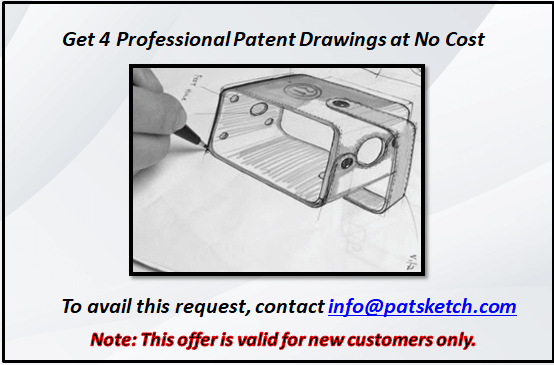
Further, for any other queries, you can write them to the same email address. Thank you very much for joining this webinar. I wish a great day ahead for all the listeners.
Other Related Articles
How to Write a Patent Application Accurately?
